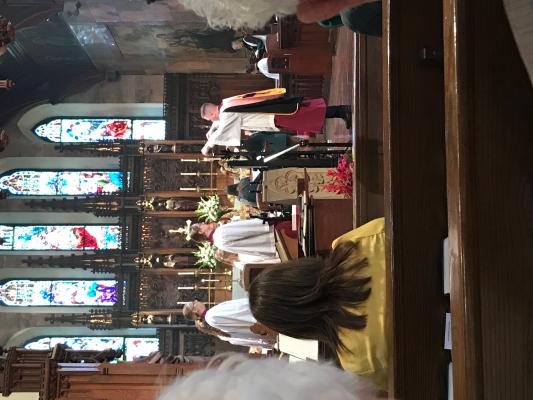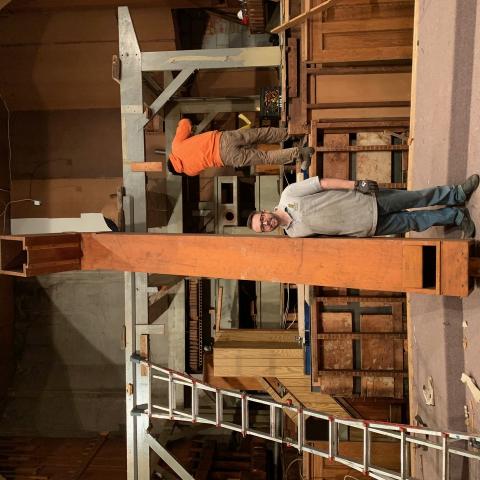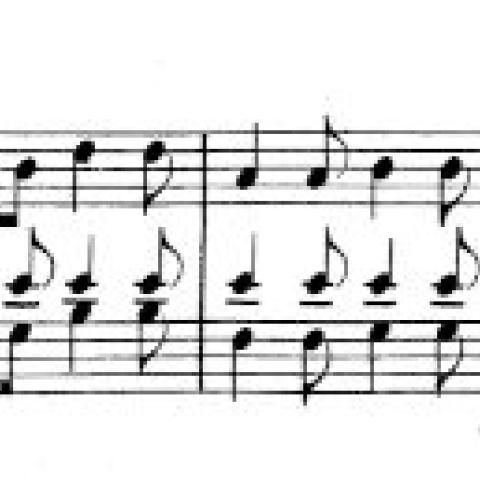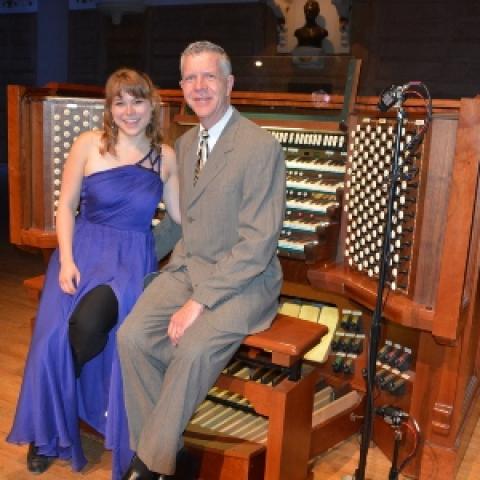John C. Hughes, D.M.A., is the music director of the Chicago Master Singers. Previously, he was a faculty member of Ripon College, Ripon, Wisconsin, where he served as director of choral activities and chair of the music department. In addition to his duties at CMS, Hughes is involved with the Green Lake Festival of Music, where he conducts the annual Composer Residency. He has held various church music positions throughout the Midwest.

Photo caption: John C. Hughes conducts at the Cathedral Church of Saint Paul, Fond du Lac, Wisconsin.
Many church choirs perform with organ accompaniment; however, they typically rehearse with a different instrument (piano) in a different space (choir room). Although this situation may be necessary due to scheduling conflicts in the sanctuary, the limitations of the piano and the challenges of changing acoustics bear significant musical costs. These factors not only hinder each performance, but they also impede the long-term development of a choral program.
Limitations of the piano
Almost every choir across the globe uses a piano to learn notes and rhythms. And for good reason—it is a highly effective and efficient tool. But relying on the piano has several inherent drawbacks. Primarily, the piano is a crutch. Singers often earn a reputation for poor musicianship. This may at times be justified, but often singers’ lack of independence is due to not having a tactile tool to find their notes. Everything in singing depends on ear training. There is no key to press or fingering to use to sing a B-flat! Singers must find a note through other means, either from another voice part or, most likely, from the piano.
This leads to a larger issue within the culture of choirs. Singers, especially the amateur volunteers who comprise church choirs, have an expectation of being taught all their notes and rhythms in rehearsal using a piano. They are rarely taught how to learn their parts by another method or held responsible for doing so. Rather than complaining about singers’ lack of musical literacy, directors must instead consider what they are doing to help choir members become independent. But that is a whole other article!
Another problematic issue with the piano is that it uses the imperfect tuning system of equal temperament. In short, equal temperament makes every half step equally sized. This allows musicians to play in any key, modulate, and use chromaticism. Equal temperament relies on enharmonic equivalency—that an F-sharp is the same as a G-flat. However, these are actually different pitches, depending on the harmonic context. For these reasons, an “in-tune” piano is actually a compromise and not really in tune. In fact, only an octave is pure on a piano. Thus, when choirs learn to tune to a piano, they are learning to sing out of tune.1
Most organs also use equal temperament. However, the preceding concerns are lessened due to the implications of the organ’s pipes. The design of an organ excites the harmonic spectrum (overtone sequence) in a performance space to a much greater extent than that of a piano. Consequently, choirs singing with organs are able to tune to the overtone sequence more readily than when relying on a piano’s discrete pitch. Hearing intervals in this manner improves overall intonation regardless of the accompanying instrument’s tuning system.
Finally, the piano is a percussive instrument. The hammered action is an effective tool for learning rhythms. Of course, this differs significantly from the organ, an instrument with limited inherent ability to articulate. It is a distinct adjustment for a choir to go from rehearsing with a piano, which literally pounds out their notes, to performing with an organ. Additionally, organists may require an instant to change registrations within a piece, particularly after a large climax. Conductors need to be aware of when these pauses might happen and incorporate them into their interpretation. Although conductors may not have to think about this issue if they were to perform with a piano, they should teach their choirs to observe such slightest pauses when learning a piece with organ accompaniment. This process should start at the beginning of the learning sequence, even if a piano is used for rehearsal.
Acoustical challenges
Many creature comforts exist in a rehearsal room. It is a designated space for uninterrupted rehearsals, contains convenient music distribution and storage systems, has comfortable seating, and provides an area for people to gather and socialize. These attributes have their merits; however, the acoustics of a rehearsal room can significantly impair an ensemble’s growth. The typical rehearsal room is a less-than-ideal acoustical environment. Factors such as low ceilings, carpeting, and padded chairs deaden any reverberation. A dry acoustic such as this prevents a choir from hearing itself. A non-resonant space thereby impedes a choir’s ability to tune well, especially when they are tuning to a piano.
A larger issue emerges when a choir learns a piece in a dry acoustic with piano accompaniment and then moves to the sanctuary to sing in a different acoustic with a different instrument. Conductors need to appreciate fully how abrupt this change can be. In such a scenario, choir members need to adjust instantaneously to a resonant space, a non-percussive instrument, the difference in balance between a piano and organ, and new sight lines. As with a lot of musical concepts, awareness is crucial. Conductors need to be aware of how large this adjustment is. Regardless of how confident a choir may feel in the rehearsal room, they can become uneasy and tentative when it comes time to perform in worship.
Solutions
The most obvious solution to these issues is to rehearse exclusively in the performance space with organ. This may be difficult to achieve logistically, so it is best to rehearse in the sanctuary as much as possible. Conductors must utilize their limited time wisely. Instead of doing a quick run-through of an anthem, their focus should be on helping the choir “hear” the new space. They should practice very specific sections, especially ones that involve balance between the choir and organ, tempo changes, and dynamic shifts. Confoundingly, even if choirs are able to rehearse in the sanctuary before a service, an empty space likely has a different acoustic than one full of people.
It may be necessary to hold the majority of rehearsals in the choir room. If so, conductors should take preventative measures and focus on helping singers develop musical independence from the piano. One such strategy is rehearsing without accompaniment or with a reduced accompaniment, such as playing only the bass line. This will help the choir hear their parts within the harmonic context and improve their tuning overall. Another strategy is to “count-sing” or sing every note staccato on a neutral syllable. In the latter case, every note is equally short; a printed quarter note and whole note are both sung as an eighth note. These strategies encourage everyone to embody the subdivisional pulse and not rely on the piano to keep time.
Finally, conductors might consider intentionally varying their interpretations so that the choir does not lock into one way of singing a piece. An important part of conducting is training an ensemble to watch not only for the tempo, but also for rubato, phrasing, dynamics, articulations, and other expressive devices. It is important to remember that each performance space is a unique instrument itself. In performance, conductors are really playing two instruments simultaneously: the ensemble and the room. By helping a choir become more flexible, conductors gain the ability to adjust their performances in the moment to the space and accompaniment.
Conclusion
Awareness and intent are critical elements of fine music making. Tradition dictates using piano in a separate rehearsal room. However, this may not be the most helpful for the long-term development of church choir programs. Volunteer choir members deserve to feel comfortable and confident going into a worship performance. It is therefore incumbent on directors to employ and continuously hone strategies to ensure that singers do indeed feel successful.
Note
1. For more information about tuning systems and training choirs to sing in tune, consult Per-Gunnar Alldahl, Choral Intonation, trans. Robert Carroll (Stockholm: Gehrmans Musikförlag, 2008).





